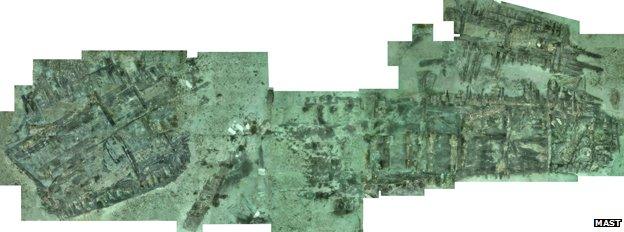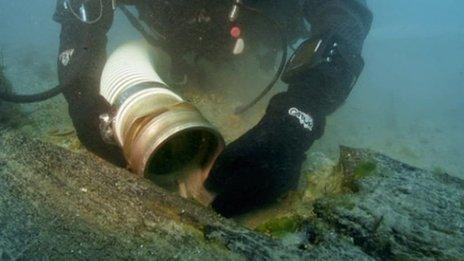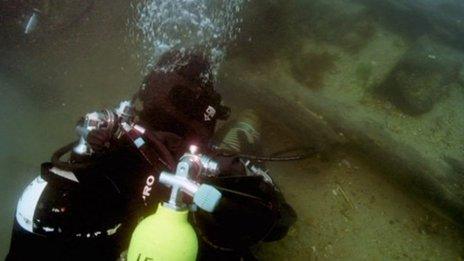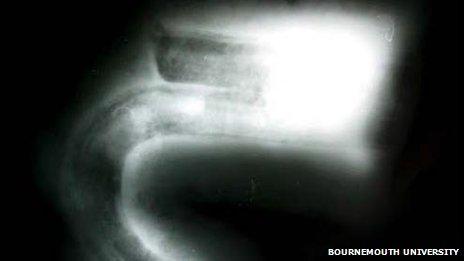Poole Swash Channel Wreck: Raising the rudder
- Published

The carved rudder was initially lifted from the seabed of the Swash Channel in July
After four centuries, a mysterious moustachioed face is set to gaze out over the waves of Poole Harbour once again.
The man's visage is carved into the rudder of what is thought to have been an early Dutch trading ship.
The vessel has lain seven metres below the surface of the English Channel, off the Dorset coast, since sinking in the early 17th Century.
Marine archaeologist Dave Parham called the eight-metre rudder, which is due to be brought ashore on Monday, "quite an astonishing find".
The so-called Swash Channel Wreck prompted one of the biggest underwater investigations of recent years, but unlike the Mary Rose - which was raised from the Solent in 1982 - little is known about the vessel or its crew.
It was discovered in a sand and shingle bank which was struck by a dredger in 1990.
What makes the wreck stand out are the early Baroque-style carvings on wooden sections of the ship, including a merman and two cherubs from the gunports.
They are among the earliest of their kind found anywhere in the world.

The remains of the wreck have been recorded over a 40m x 50m area
With a Mary Rose-style recovery operation being prohibitively expensive, marine archaeologists from Bournemouth University led efforts to rescue parts of the ship deemed most at risk from degradation caused by underwater organisms such as gribble and shipworm.
The bowcastle, part of the upper structure of the ship, was raised in 2011 and 12 metres of the bow followed the next year.
However, they had to wait until this summer for seven successive days of calm weather in order to raise the rudder.
After being lifted in July, it was temporarily placed underwater along the quayside at Poole.
Dave Parham said: "The rudder was partially buried and sticking out from the seabed. We couldn't build protection around it so we took the decision to raise it."
The rudder is the last major piece due to be raised. The remaining wreck has since been covered in sand to protect it from the seawater.
"Particularly in the current economic climate, it's just too expensive to raise everything - you're looking at tens of millions of pounds, and then having to provide a long term future for it.
"Left as it is, it could remain for several hundred years. If we recovered it and ran out of funding to look after it, we'd have effectively destroyed it," explained Mr Parham.
Mystery vessel

Almost 80% of the port side of the ship has survived since it sank

Marine archaeologists from Bournemouth University have charted the wreck and raised pieces which cannot be preserved under water

The remaining parts of the wreck have been covered in sandbags to protect it from damaging exposure to seawater

Iron hooks have been x-rayed as part of the analysis of the finds

A glazed drug jar and wooden carving from the gunport were found on the seabed
Artefacts recovered from the ship include cannons, leather shoes and wooden barrels, as well as copper, pewter and ceramic plates and cups.
The Marine Archaeology Sea Trust is conserving three of the wooden carvings and a canister of cannon shot which have already been raised.
Jessica Berry, of the trust, said: "The Swash channel wreck is one of the largest shipwreck investigations within the UK. We're very proud of it - it's provided us with some of the oldest shipwreck carvings in England."
However the name, route, crew and cargo of the stricken vessel remain a mystery, beyond early tests on the timbers showing "indications of a Dutch connection".
"It's surprising - it was a large, ornate, well armed ship so it should survive in record or in the popular imagination, but there is nothing - or if there is we haven't found it yet," said Mr Parham.
What is clear is that it is one of only a handful of known wrecks from a time which marked the beginnings of global trade.
"From a European context, in the 16th Century people were going out and discovering maritime routes to the Indies and the new world. They were exploiting these trade links - bringing silks and spices back from South East Asia," he said.
How it ended up on the seabed is also a matter of conjecture. Mr Parham believes it was wrecked travelling past Poole, heading to or from a European port to the Mediterranean or South East Asia.
The rudder and other artefacts are due to go on show in Poole Museum next year.
Manager Michael Spender, described it as "an outstanding piece of sculpture".
"It's fantastic - such a rare ship from the birth of global trade which Poole played a major part in," he added.
He also said there was potential for a "shipwreck museum" to showcase the harbour's maritime heritage, which would also include an Iron Age log boat discovered in 1964.
In the meantime, months of painstaking analysis of raised timbers, ropes and artefacts lie ahead, with the tantalising prospect of learning more about Poole's mystery wreck.
- Published14 May 2011